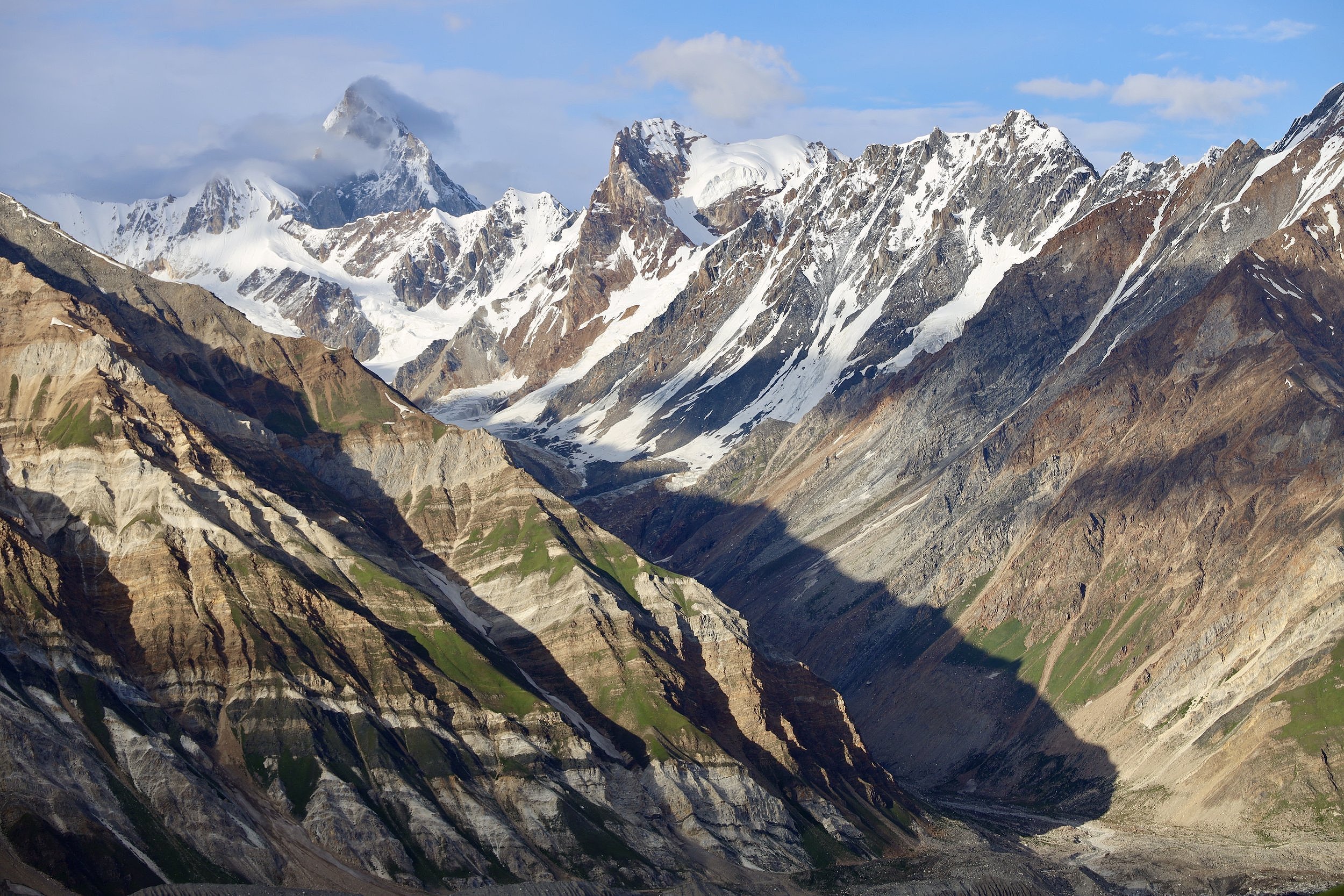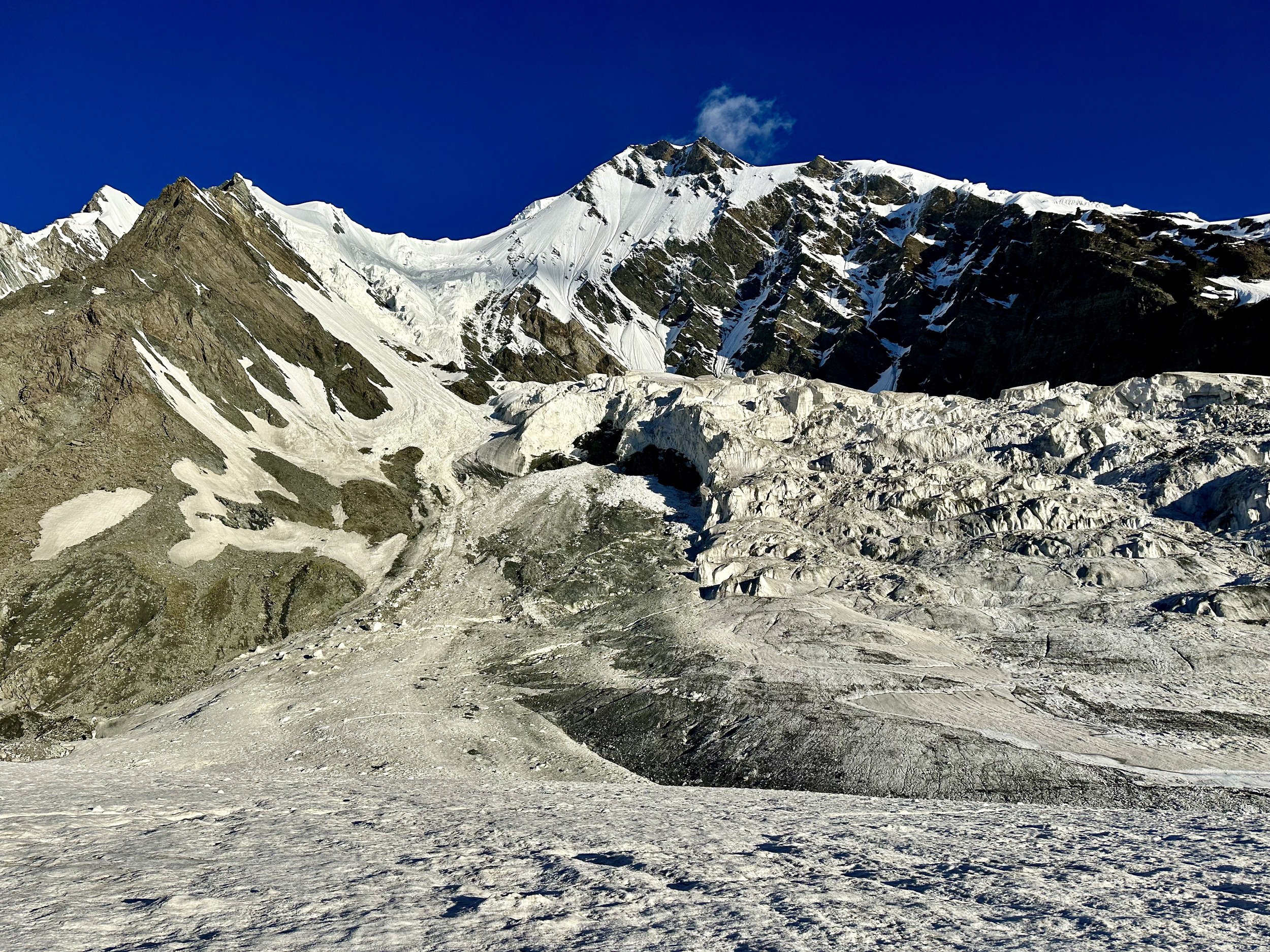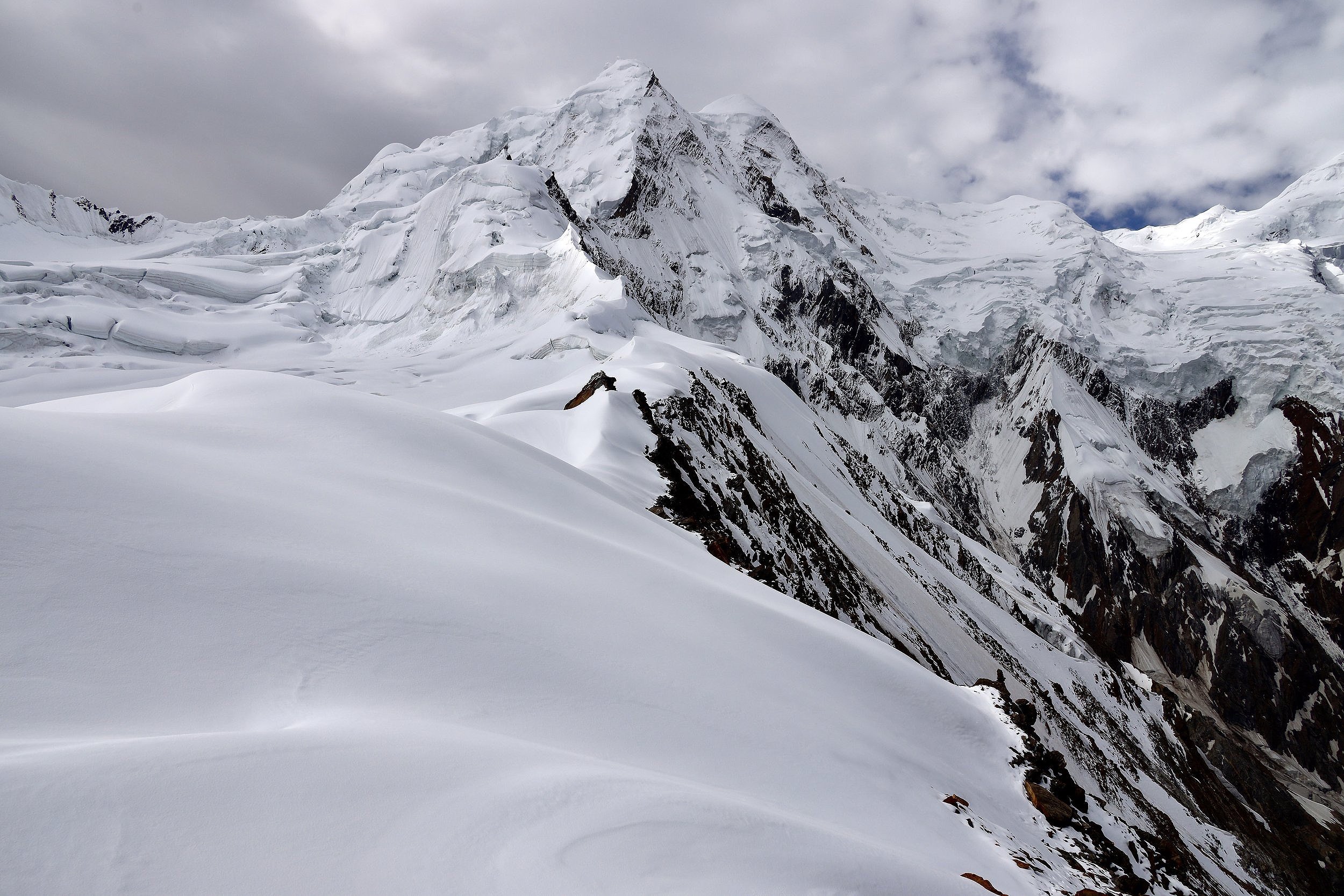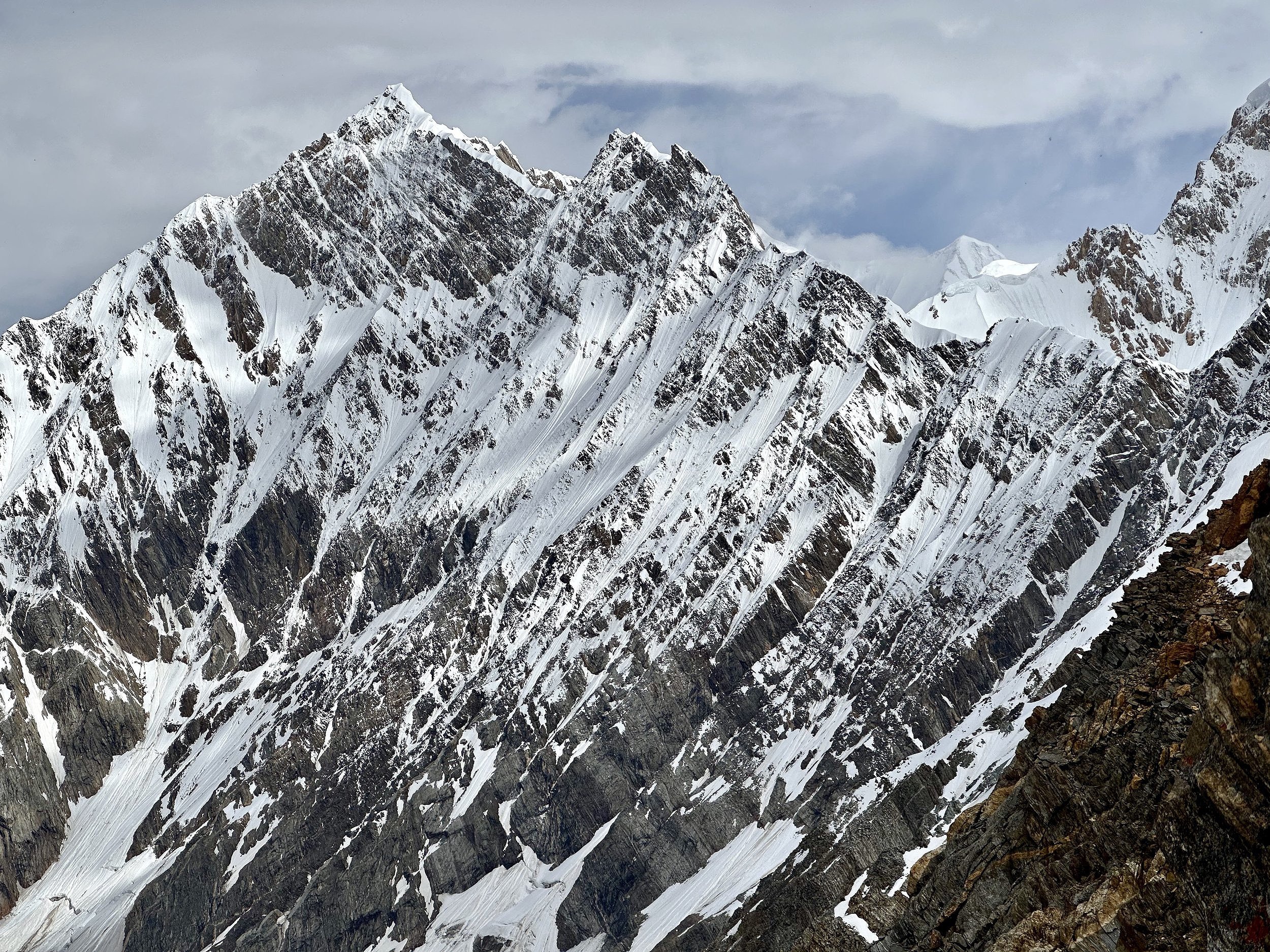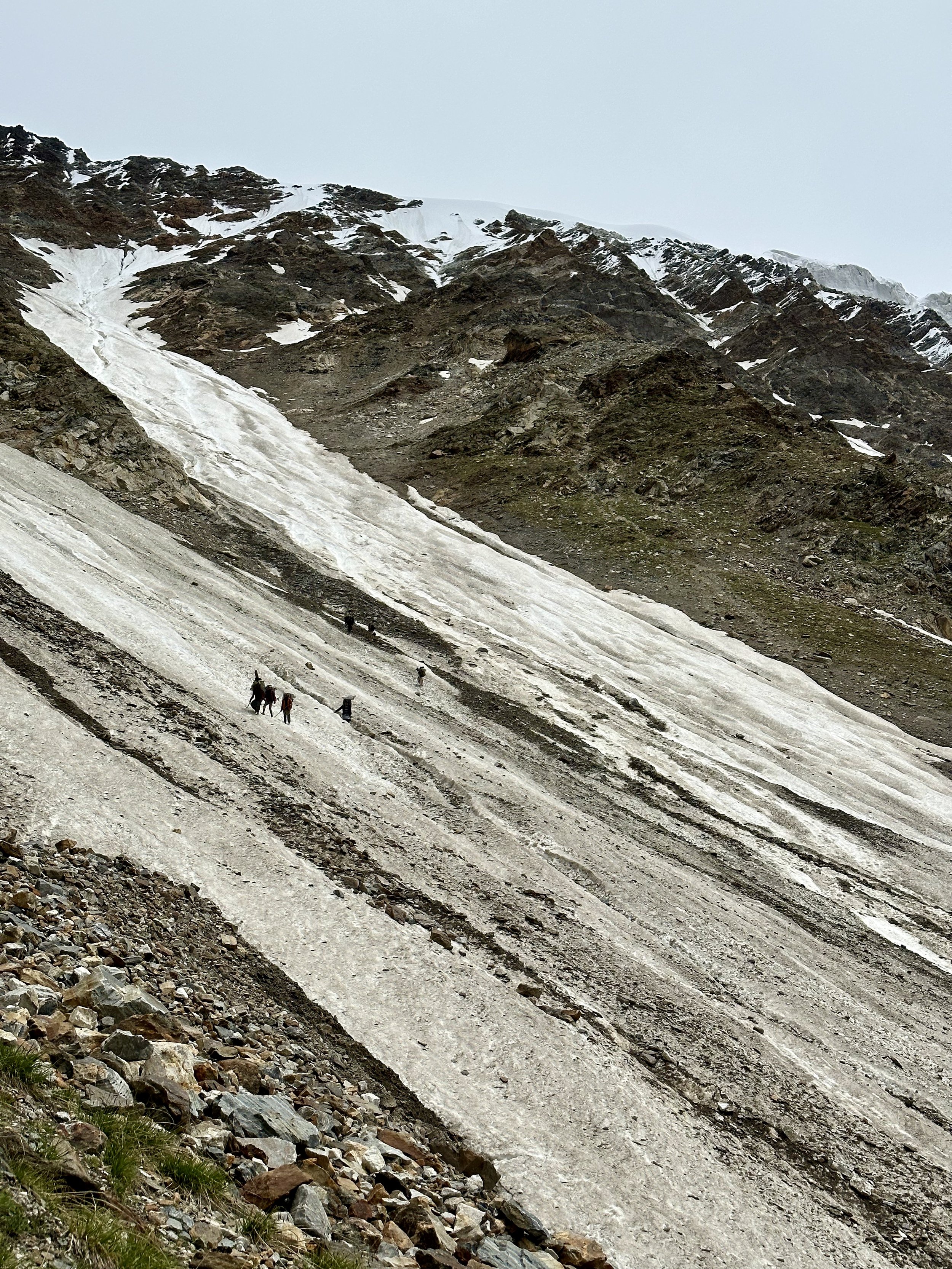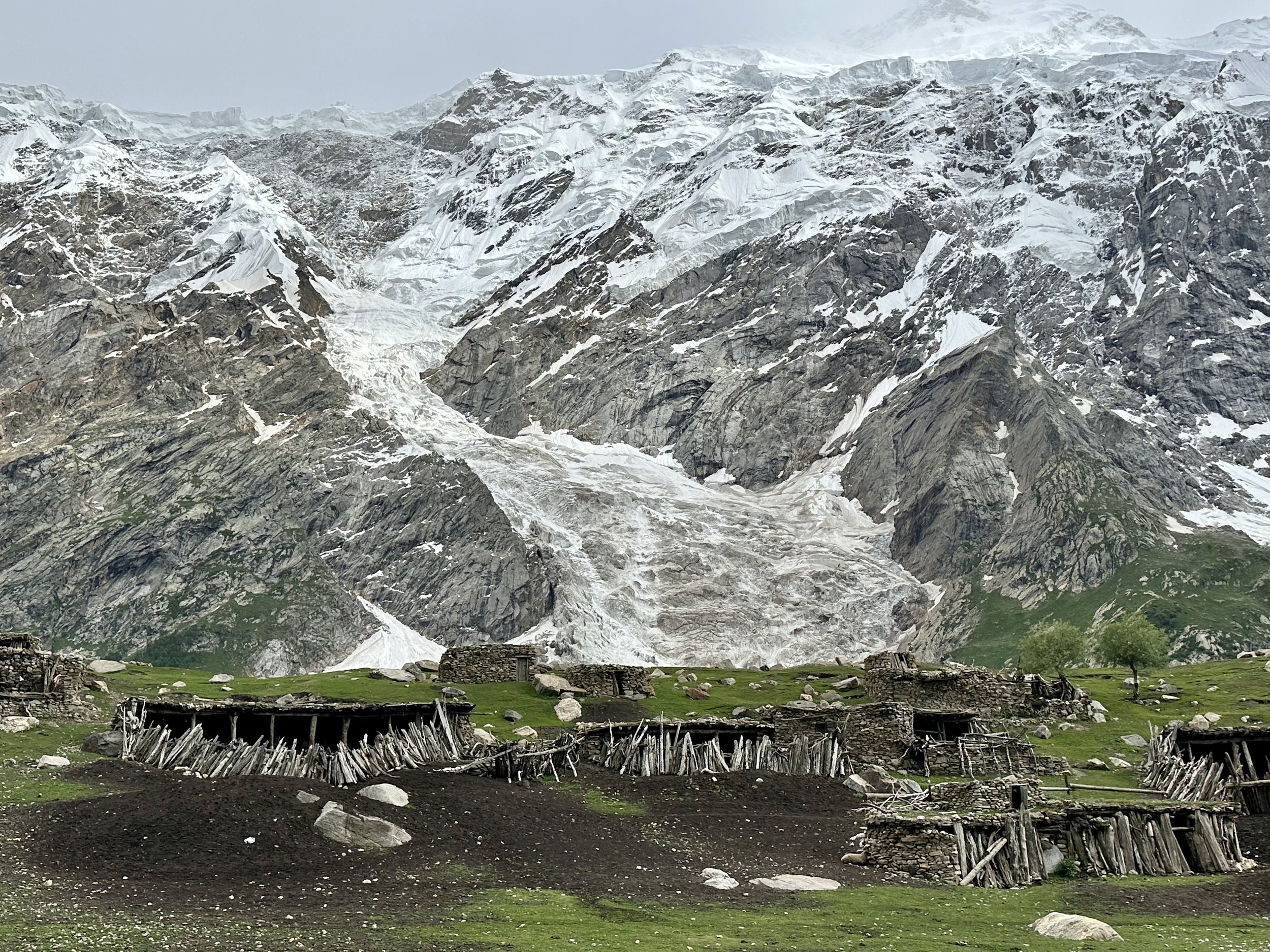Haramosh La is one of the more challenging passes to cross in the Karakoram. It is situated in the Lesser Karakoram Range but there is NOTHING lesser about it. The altitude is gained very rapidly (from 2000m to 5200m in 3 days), the ascent is dotted with crevasses and the descent is a 1500m drop on day 1 and another 1500m on day 2. The descent slope is a 50 degree mass of loose rocks that is just waiting to be dislodged and catapult down to the valley. One has to descent the slope diagonally to avoid dropping rocks on anyone below in the party. We had a very competent local guide Hussain from Arando. He was incredibly fast, strong and knew the best way up the Haramosh Glacier and down to the Kutwal Valley. The upper section is quite steep but nothing overly serious. The loose terrain was the biggest challenge with our large group of porters. If the upper section is iced up or snow covered, a fixed rope would be required. We were fortunate to have dry conditions.
Haramosh La is considered the most technical, difficult and dangerous pass in Pakistan.
It is considered a very difficult trek as the glacier on the upper Chugolangma is heavily fissured with the danger of avalanches. The ascent is steep on the west side, requiring the use of rope almost 600/700 meters. It is a challenging trek and is only suited to experienced trekkers with technical mountaineering experience.
The temperature went from -10C on top of the pass to +45C at 2200m in the narrow valley with heat radiating walls. The ever-changing and unpredictable weather adds to the challenge as the pass can only be crossed in clear weather. Crossing it in a snowstorm or rain would be quite dangerous on the descent.
It is not a popular trek and the pass is crossed very rarely (once or maybe twice per year, in a good year). I had it on my radar since 2013 and I finally made it. It is an incredible place with absolutely stunning scenery. Not easy to get to but definitely worth the effort.
Thanks to Adventure Karakoram Pakistan and Ghulam from Mountain Travels Pakistan for their assistance, hospitality and great service!
The overview of the Lesser Karakorum. Rakaposhi, Haramosh and Diran are situated in that range. All are over 7000m high.
Map of the Haramosh Glacier and Haramosh La (lower left).
Starting point of the trek is Arando, a 6 hr drive from Skardu.
Map of Chogolugma Glacier, Haramosh Glacier and Haramosh La.
The long glacier on the left is Chogolugma. The Glacier on the right is Hispar. Haramosh Glacier is on the left side flowing into the Chogolugma Glacier in the middle left of the photo.
The Indus River and Shigar Valley
Shigar Valley
Shigar Valley
Shigar Valley
Shigar Valley
Shigar Valley
Shigar Valley
The confluence of Shigar and Basha Rivers. We are going into the valley ahead. The road to Askole turns right.
Basha River Valley. The high mountain on the right is Bargincho 5790m.
Driving to Arando
Camp 1 in Arando
Negotiating with porters in Arando
Arando, bridge over Basha River
Arando
Arando, Basha River
Arando is very close to the terminal moraine of the Chomolugma Glacier and the source of the Basha River.
Arando village in the distance
The terminal moraine of the Chomolugma Glacier
We climbed quite high on day 2. Day 3 and 4 we stayed put to wait out the rain.
The road to Arando and Basha River
Arando village and the terminus of the Chgolugma Glacier.
Our first camp on the Chogolugma Glacier. We stayed here for two nights to wait out the rain. Since it was a cow pasture we had hundreds of flies in our tents.
Chomolugma Glacier
Day 5 was long but the march was along a flat side valley next to the Chomolugma Glacier.
A beautiful flower filled side moraine of the Chogolugma Glacier. Spantik is directly ahead.
Second East Haramosh Glacier and Paraber Peak 6,315m.
Chomolugma Glacier with Malubitung Peak 7453m on the horizon.
Our camp before we veered off onto the Haramosh Glacier seen in the distance on the left.
Chomolugma Glacier
On the Chomolugma Glacier
Chomolugma Glacier
Malubiting 7453m
Upper Chomolugma Glacier
Malubiting 7453m
Haramosh 2 with its summit in the cloud.
Spantik is right in front. You can see the ascent ridge and the entire route of the climb.
Chomolugma Glacier
On Haramosh Glacier
On Haramosh Glacier.
Haramosh Glacier. We had to bypass the heavily crevassed frontal section of the Haramosh Glacier.
Haramosh Glacier
The confluence of the Haramosh and Chomolugma Glaciers.
Sgari Glacier and Bolocho 1 (high peak on the left 5850m).
Bolocho 1
The heavily crevassed Haramosh Glacier.
Haramosh Glacier
Our incredible camp on the Haramosh Glacier. This is the bc for the Pass.
Pointing at the pass 12 km away and another 1000m up along the upper reaches of the Haramosh Glacier.
Early morning on the upper Haramosh Glacier
Haramosh 2 6666m and Mani Peak 6685m with he Haramosh La 5150m ahead.
The sunrise on the Haramosh Glacier
Sunrise on Haramosh 1 7406m.
Laila Peak icefall with Laila Peak 6986m above.
Haramosh 2 6666m.
Haramosh 2
Mani Pk and Haramosh La. See the porters for scale.
Taking a break before roping up on the Haramosh Glacier.
Laila 1 Peak 6985m
Unnamed Peak along the upper Haramosh Glacier.
Laila 1 Peak 6985m and behind, Laila 2 6765m
Sun halo on Haramosh 2
Mani Pk and the icefall that we had to cross to get to Haramosh La
Looking down the Haramosh Glacier. Laila Pk on the left and Haramosh 2 on the right.
Mountains of the Hispar Glacier area above the Chgolugma Glacier
Haramosh 2 from Haramosh La
Haramosh La. Haramosh 1 is on the right.
Add another 100m
Mountains above Haramosh La
Mani Pk and Haramosh La
Haramosh La, Mni Pk and Haramosh Pk.
Mani Pk 6685m and Haramosh La 5200m
Mani Pk 6685m, Haramosh La and the steep descent slope
Haramosh 1 Pk 7,406 and the descent slope from Haramosh La.
My guide Essan and my guide’s guide Hassan from Arando.
Mani Glacier and the Kutwal Valley. Kutwal Lake (our destination for the day) is 1500m below and 8 km away.
Laila 2 and Rakaposhi on the horizon.
In the distance on the right is Rakaposhi 7788m
Bilchar Dobani 6134m
Rakaposhi is the high peak on the right in the distance.
Laila 3 6375m from Haramosh La
The descent slope. Laila 3 and Laila 2 tower over our route.
The porters had to be extra careful with the loads.
The descent is quite steep at the top
The grade of the descent slope
Haramosh La 5150m and Haramosh Mountain 7409m ( on the right).
Hassan the guide from Arando is looking up to check on the the descending porters.
Coming down Haramosh La. Mani Glacier is below.
Hassan has balls of steel - no rope or ice axe, in plastic shoes with steep drop-offs on both sides. I was watching this and slowly realizing that I was next to follow him.
Haramosh 1 Mountain 7409m half way down from the pass.
Lower section of the descent slope. We descended from the top of the pass diagonally to avoid rockfall. The slope was very loose and we sent rocks flying many times. Crossing the snow gullies in plastic shoes was quite challenging for the porters but no rope was used at any point.
Mani Pk and Haramosh from the descent of the Haramosh La
Mani Pk and the Haramosh La from the bottom of our descend route.
Haramosh 1 Mountain and the head of the Kutwal Valley.
Haramosh La 5150m and our descent route.
Haramosh 1 Mt 7409m
Haramosh La
Beautiful sunset on the Haramosh La from our camp at the Kutwal Lake.
The camp at the Kutwal Lake with Haramosh 1 towering above.
The beautiful but small Kutwal Lake and Haramosh 1.
Our Haramosh La team with Malubiting 7453m behind.
The incredible scenery of the Kutwal Valley. Malubiting West 7458m (centre), Malubiting Centre and East 6970m (right). The glacier flowing from Malubiting is Baskal Glacier. What an incredible place!
Pastures of the upper Kutwal Valley
Haramosh 1 and the terminal moraine of the Mani Glacier.
The crazy road to the KKH!
Looking up-valley with Miar 2and 3 dominating the skyline.
Miar 2 6,790m and 3 Mt 6,635m and the crazy road to Sassi and the KKH.
Sasso and the KKH can be seen below. KKH follows the Indus River Valley
Sasso and the KKH.
























































